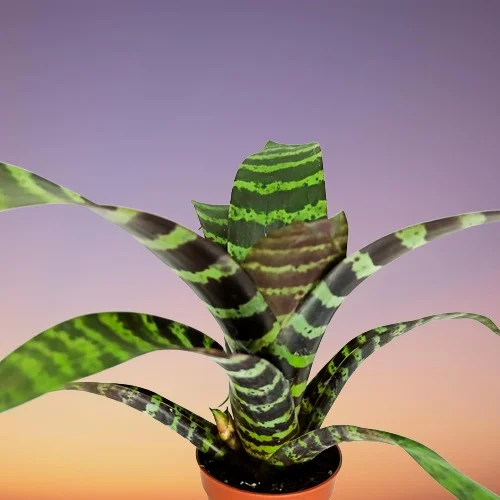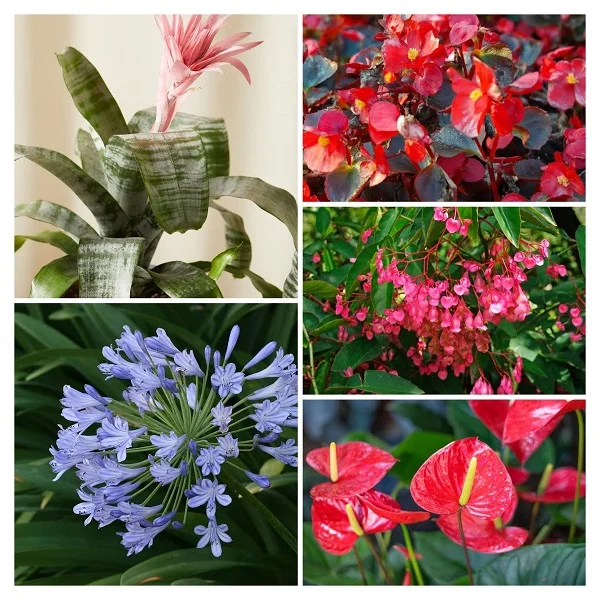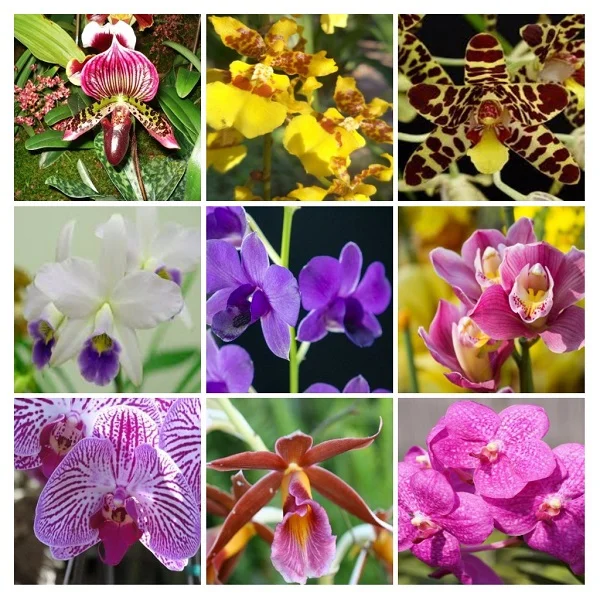10 Bromeliad Plant Types with Names and Pictures
Some links in this post may be affiliate links
Bromeliads are popular indoor plants grown for the beauty of their foliage or for the beauty of their blooms. A few like the Aechmea fasciata and Vriesea splendens belong to both camps.
The usual pattern for Bromeliads is a rosette of leathery, strap-like foliage and a bold flower-head which arises on a stalk from the cup-like center of rosette.
A Bromeliad may take several years to reach the flowering stage but the display may last several months. The flower head in most cases is due to the presence of showy bracts as the true flowers are small and short-lived.
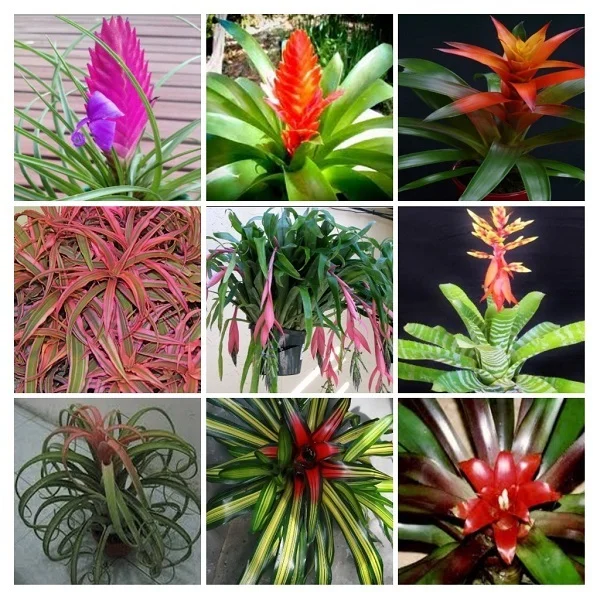
Once the flower-head fades, the rosette of leaves begins to die and is replaced by offsets (pups) at the base of the plant which can be used to propagate new plants.
There are over 3700 Bromeliad species mainly native to the tropical Americas, with some species being found in the American subtropics and one species, Pitcairnia feliciana found in tropical west Africa.
Bromeliads are considered non-toxic to humans and pets. They are safe to grow in the home. However, their leaves bear short spines which may cause physical injury if handled with bare hands. Always wear gloves when handling these plants to prevent injury.
If you are looking to add these plants to your collection, you may obtain beautiful Bromeliads online from Amazon (Link to Amazon). We have outlined herebelow 10 best Bromeliads to make it easier for you to make your selection.
10 Different Types of Bromeliads for Indoors
Popular Bromeliad Varieties are Air Plants, Queen's Tears Plant, Blushing Bromeliads, Flaming Sword Bromeliads, Bird's Nest Bromeliads, Earth Stars Bromeliads, Ananas Bromeliads among others.
1. Air Plants (Grey Tillandsia)
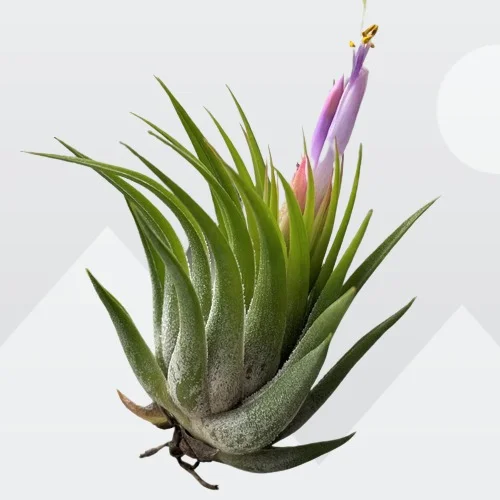
Air Plants are unique plants with absorbent furry scales on their foliage called trichomes which take up water from humid air and obtain nutrients from air-borne dust; it can be said that they literally live on air.
The Air Plants are not planted in soil but are displayed by sticking them on coral, shells, drift wood or by hanging them among many other ways.
Air Plants are some of the most popular plants for indoor growing due to their ease of care and vibrant colors when in bloom.
Grey Tillandsia blossom in bright indirect light, warmth of 18-260C, humidity of 70-80% and fortnightly feeding in the growing season.
Learn more on how to grow and care for Air Plants
2. Pink Quill Bromeliads (Green Tillandsia)

Pink Quill Bromeliads are vibrant plants which bear a large spectacular flower-head made up of pink bracts and blue flowers.
These Bromeliads are evergreen, perennial flowering plants with long, grassy, green leaves. The flower-head is flattened, about 9-12 inches long and can last up to 3 months. They are some of the best indoor flowering plants.
Pink Quill Bromeliad flourishes in bright indirect light, warmth of 18-280C, humidity of 60-70% and consistently moist, rich, well-drained orchids potting soil coupled with regular feeding during the growing season.
Check out our guide on how to grow and care for Pink Quill Bromeliads
3. Bird's Nest Bromeliads (Nidularium Bromeliads)

Nidularium Bromeliads have a central rosette of very short saw-edged leaves (Bird's nest) which turns bright red at flowering time and 1 foot long leaves below the bird's nest.
The popular varieties of Bird's Nest Bromeliads are Nidularium fulgens, Nidularium innocentii and Nidularium innocentii striatum whose foliage will create a spectacular sight in any plant collection. Nidularium Bromeliads are some of the best tropical foliage plants for the home.
Bird's Nest Bromeliads blossom in bright indirect light, warmth of 18-280C, humidity of 60-70% and consistently moist, fertile, well-drained orchids potting soil coupled with fortnightly feeding in the growing season.
Read more on how to grow and care for Bird's Nest Bromeliads
4. Blushing Bromeliads (Neoregelia Bromeliads)

Blushing Bromeliads are foliage bromeliads grown for their beautiful central rosette of leaves which turns bright red at flowering time.
In some species of Neoregelia Bromeliads, the leaves at the center of the rosette blushes (change color) when about to flower and hence the common name. In other species, the leaf-tips change color as the plant is about to flower and they referred to as 'Fingernail Plants'. They are some of the best plants for the home on account of their ease of care and their magnificent foliage.
Blushing Bromeliads grow best in bright indirect light (filtered light), warmth of 18-280C, humidity of 60-70% and consistently moist, fertile, well-drained orchids potting soil coupled with fortnightly feeding during the growing season.
Check out our guide on how to grow and care for Blushing Bromeliads
5. Queen's Tears Bromeliads (Billbergia Bromeliads)
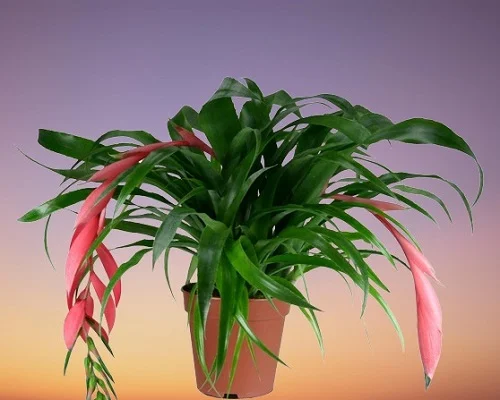
Queen's Tears are some of the easiest Bromeliads to grow. They are grown for the beauty of the drooping showy flower-heads whose bracts are about 3 inches long.
The drooping flower-head and the 1 foot long, arching leaves which turn reddish under good light look spectacular in a hanging basket. Billbergia Bromeliads are some of the best indoor flowering plants for hanging baskets.
Billbergia Bromeliads blooms in bright indirect light, warmth of 18-280C, humidity of 60-70% and moderately moist, rich, well-drained orchids potting soil coupled with fortnightly feeding in the growing season.
Read more on how to grow and care for Queen's Tears Bromeliads
6. Flaming Sword Bromeliads (Vriesea Bromeliads)
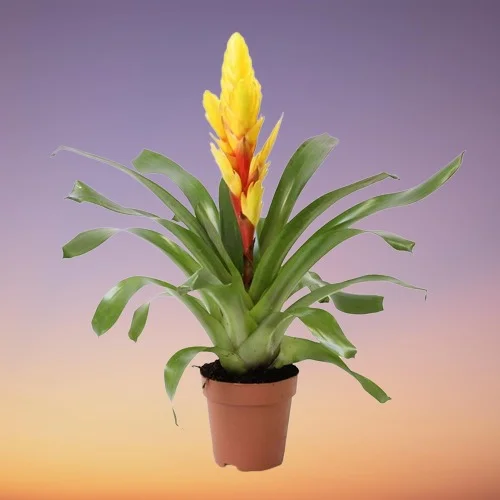
Flaming Sword Bromeliads are easy-care, typical Bromeliads with a central vase surrounded by a rosette of arching, smooth-edged leaves, about 1-1.5 feet long.
The flower-head in Flaming Sword Bromeliads is upright, sword-like and up to 2 ft long with bright red bracts in some species but in others the flower-head is more spreading.
Some species of Vriesea Bromeliads like Vriesea hieroglyphica and Vriesea fenestralis are grown more for their striking foliage rather than for their blooms. Flaming Sword Bromeliads are among the best plants for a living room for a great first impression.
Flaming Sword Bromeliad flourishes in bright indirect light, warmth of 18-260C, humidity of 60-70% and moderately moist, fertile, well-drained orchids potting soil coupled with fortnightly feeding during the growing season.
Read more on how to grow and care for Flaming Sword Bromeliads
7. Scarlet Star Bromeliads (Guzmania Bromeliads)
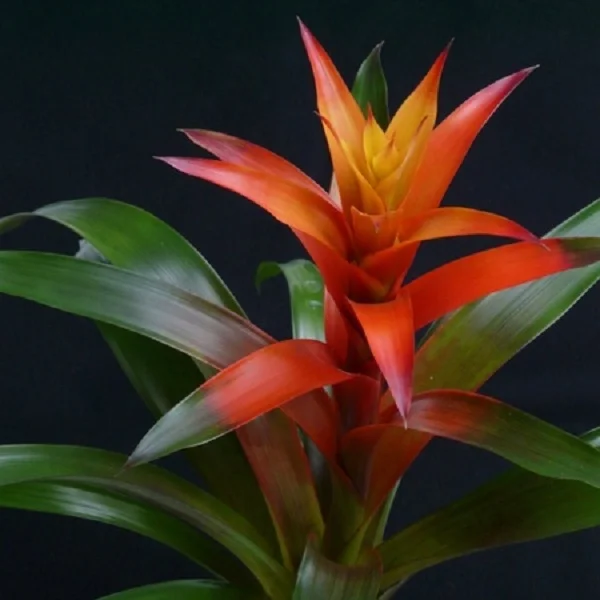
Guzmania Bromeliads are popular Bromeliad plants grown for the beauty of their bright-red or orange showy flower-heads with a central cluster of small white flowers.
Scarlet Star Bromeliads are typical Bromeliads with leathery, arching leaves and a distinct central 'vase' from which stout stalk bearing a bold flower-head emerges. They are some of the best flowering plants for the home.
Guzmania Bromeliads perform best in bright indirect light, warmth of 16-260C, humidity of 60-70% and moderately moist, fertile, well-drained bark soil coupled with regular feeding in the growing season.
Learn more on how to grow and care for Scarlet Star Bromeliads
8. Urn Plants (Aechmea Bromeliads)
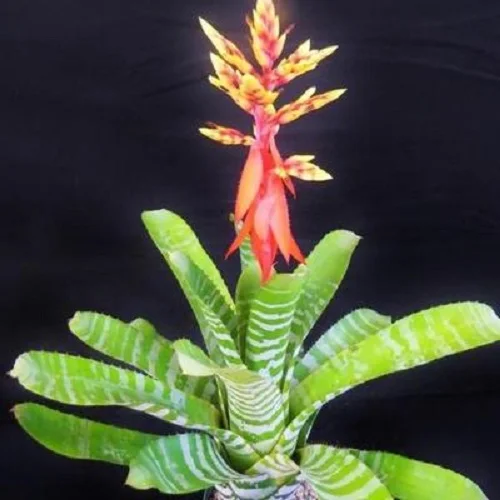
Aechmea Bromeliads commonly called Urn Plants are popular plants that are grown indoors for the beauty of their foliage and for the beauty of their flowers.
They are typical Bromeliad plants varieties with leathery, arching leaves and a distinct central 'vase' from which a stout stalk bearing a bold flower-head emerges.
Urn Plants flourish in bright indirect light, warmth of 15-260C, humidity of 60-70% and consistently moist, rich, well-drained orchids potting soil coupled with fortnightly feeding in the growing season.
Read more on how to grow and care for Aechmea Bromeliads
9. Earth Stars Bromeliads (Cryptanthus Bromeliads)

Cryptanthus Bromeliads are stemless, terrestrial, low-growing, moisture-loving Bromeliad plants whose small, wavy-edged, colorful leaves make spectacular plants in any space.
Due of their requirement for warm and humid conditions, and spectacular foliage, Earth Stars are among the best plants for a closed terrarium as a high humidity can be maintained inside a terrarium.
Earth Star Bromeliads blossom in bright indirect light, warmth of 18-260C, humidity of 60-70% and moderately moist, rich, well-drained orchids potting soils coupled with fortnightly feeding during the growing season.
Learn more on how to grow and care for Earth Stars
10. Ornamental Pineapple (Ananas Bromeliads)
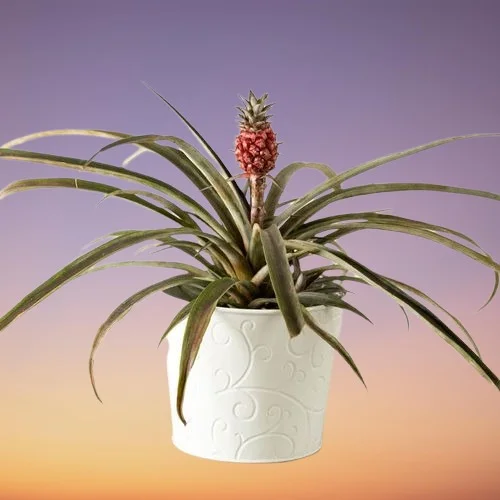
Ornamental Pineapples is a group of Bromeliads which produces pink flower-heads on mature plants followed by small aromatic but inedible fruits if grown under warm and humid conditions.
Ananas Bromeliads are grown for their striking foliage which makes them a spectacular sight to behold. The leaves are sword-shaped and sharp-pointed and grow in a rosette. They are among the best plants for the front porch or entrance.
Ornamental Pineapple Plants blossom in very bright light with 6-8 hours of direct sunlight, warmth of 18-270C, humidity of 50-55% and moderately moist, fertile, well-drained orchids potting mix coupled with fortnightly feeding in the growing season.
Learn more on how to grow and care for Ornamental Pineapples
You liked it? Share on social media.
Related Content
Amazon Associates Disclosure
Homeplantsguide.com is a participant in the Amazon Services LLC Associates Program, an affiliate advertising program designed to provide a means for sites to earn advertising fees by advertising and linking to amazon.com.
